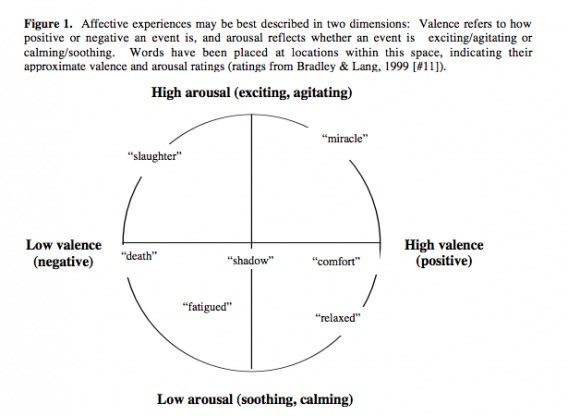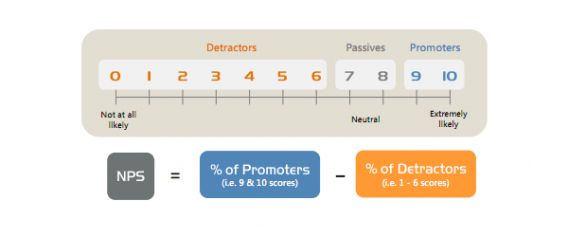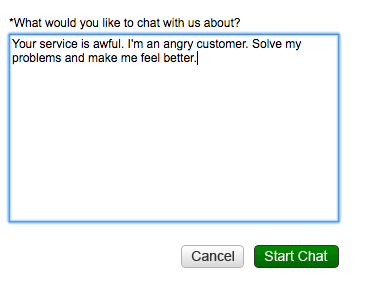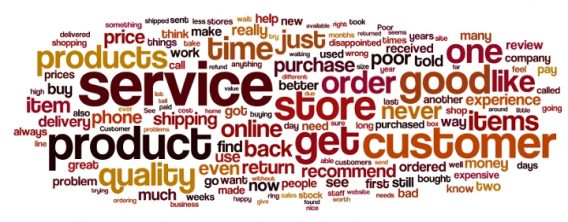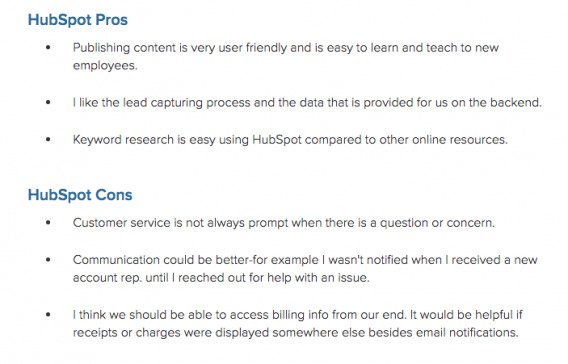NPS isn’t the end-all be-all of customer data. But it does give you some insight into customer loyalty and satisfaction.
One of its greatest powers is segmenting customers into three parts: detractors, passives, and promoters. This lets you market to them in different ways. You can send targeted campaigns to promoters, try to convert passives into promoters, and try to solve the problems that detractors complain about.
But can you turn a detractor into a promoter?
In my opinion, it might be easier to change a detractor into a promoter than a passive into one. Why? Because they’re passionate (albeit in a negative direction). Passives probably just don’t care enough to have a strong opinion – in either direction.
You’ve already lit a fire under both detractors and promoters; all you need to do is leverage that fire to push it in a positive direction.
Emotional Arousal And NPS
Those who rate you high (9-10) as well as those who rate you low (0-3) tend to have had emotionally provoking experiences. They love you or hate you. There’s a term for this in academic literature called “emotional arousal,” which is a combination of a physiological and psychological response to an experience.
Think about the last time you gave a big speech, or when your team was on the verge of winning a big game.
Your palms were sweaty and your heart was pounding – the same physiological reactions that occurred when you were last at a scary movie or went camping and heard a weird noise outside your bed. That’s the mark of high-arousal emotions.
Now, winning a big game and hearing a scary noise outside of your tent when camping are on opposite sides of the valence spectrum – that is, how negative or positive they are.
What you really want to trigger in your customers is an experience that is, at the same time, both high-valence and high-arousal. That, in theory, would persuade them to rate themselves as a promoter and advocate for your brand.
Basically, aim for the upper-right quadrant of this visual (in this theory, the upper-left quadrant would be associated with detractors’ experiences – both negative and high arousal):
I want to note, too, before we go into strategies to create more promoters, that NPS has its faults as well as its limitations.
It’s a great high-level segmentation, but in optimization, there are other ways of improving and measuring the user experience as well. As Lincoln Murphy, Growth Architect at Winning By Design, said, “It’s critical to understand that NPS is a lagging indicator and only tells part of the story.
Can You Turn Detractors Into Promoters?
I asked some top customer experience minds whether or not is was possible to change a detractor into a promoter. Almost all of them said, yes, it was.
The caveat? It’s pretty difficult to do so. It’s an art as well as a science. But there are some best practices that can aid you in the process.
We all know how important word of mouth is for business, so by focusing some attention on turning negative word of mouth into positive word of mouth, you’ll be unlocking some pretty outstanding ROI.
As it turns out, the best thing you can do is to prevent customers from becoming detractors in the first place…
Make It Easy For Customers To Complain
There are many strategies designed to create promoters (and books written about it). But one of the most effective ways of doing so (while also collecting valuable customer feedback) is to allow frequent and easy places for customers to give you feedback.
Lincoln Murphy put it well:

Lincoln Murphy:
“Don’t let customers get to the point where they’ll be a detractor in the first place; you do this by understanding their Desired Outcome and operationalizing around ensuring they achieve that – also known as Customer Success.
Make sure you give the customer other places to provide feedback ad hoc: feature requests, bug reports, open support tickets, chat with your team, etc.
Don’t let the NPS survey be the only way – or the only time – they can feedback to you.
Continually remind them that those other feedback modalities are there for them to use.
This way, when you do get a detractor you know it’s probably legit and not venting all of the pent up – and not even entirely negative but it becomes so with no outlet – sentiment.”
You know the value of honest customer feedback for optimization. It helps you find problems as well as possible solutions to them.
In addition to providing this qualitative insight, allowing many outlets to complain can cut criticism off before a customer resorts to telling their friends. If they can vent directly to you, it takes a lot of the power and passion out of the complaints (especially if you can solve their problems in real time with something like live chat).
Negative word-of-mouth is no treat for a company. According to AllBusiness.com:
“Most unhappy customers don’t take the time to complain, they just quit doing business with you. But guess what: They didn’t say anything to do, but they definitely telling all their friends. The experts say, the average upset customer tells nine people.
So what can you do? To avoid losing customers because of a bad experience, you need to make it easy for them to complain. That’s right. Let them know their complaints are welcome. Keep in mind, a complaining customer cares enough about the relationship with your business to at least bring the issue to your attention.”
How do you actually implement that? You can create your own feedback forms or you can use a tool like live chat (Olark, Live Chat, Intercom) or a user feedback tool like Qualaroo, Qeryz, or Usabilla. In addition, you should put your contact information (email, phone, etc.) prominently across your site and communications.
Find Out, Broadly, What Users Want
Baazarvoice, a user generated content tool, analyzed 30,000 net promoter comments from over 550 brands to find what promoters and detractors tended to write about in their comments.
For promoters, they found that, in general, the store experience (mostly having friendly and helpful staff) is the most important. Promoters also talk about:
- prices
- delivery
- value
- selection/variety
- shipping
- speedy service
Detractors, for their part, were concerned about the same things:
- store experience
- online orders
- shipping
- and delivery
Poor customer service and product quality were the largest problems. These aren’t easy problems to solve. They’re the crux of running an eCommerce site, really.
Of course, Baazarvoice’s data is based on a large scale sample across many industries. You, too, can do your own qualitative research and discover what your own promoters and detractors are commenting on.
Spin up some on-site surveys as well as customer surveys. Collect feedback regularly with Kampyle or Usabilla. Do regular User Testing and look for the bottlenecks. Find out what works more often than not for specific sites using industry research. Then combine the data and focus on the most common and important issues, and you should see some results, both in NPS and conversion rate.
Take a look at a word cloud we created from a survey placed on a client’s site (checkout page):
Can you tell what the problem was? We could probably make a safe inference here.
Then Come Up With a Unique Solution For Each Detractor
Once you’ve got an idea of the general concerns of your site visitors – the things promoters love as well as what detractors didn’t like – investigate individual solutions for detractors to try to sway them back from the dark side. Lincoln Murphy spells it out here:

Lincoln Murphy:
“When you get the low NPS score, don’t reach out immediately.
Rather, do some research on their account to figure out why this happened – beyond what they told you – and come up with a solution.
Once you’re informed about the reason they gave you a low score and know how you’ll get them back on track, then reach out to the customer.
After you validate your assumptions, present your plan to get them back on track and ask them, “If we can get you back on track [toward your Required Outcome], next time you’re presented with an NPS survey, you’d give us a 9 or 10, right?”
Follow-up on the conversation via email with a plan to get them back on track toward their stated Desired Outcome.
When they achieve their goal or hit their next success milestone, and have no other negative indicators, email them and say “looks like you’re doing great, are back on track, and everything is good. I just wanted to make sure I’m not missing anything.”
If the answer is positive, take them off the “do not NPS” list and either send one right away or wait until the next round of surveys goes out. Either way, they should become a promoter.
Of course, just because they identify as a promoter (NPS of 9 or 10), doesn’t mean they actually promoted for you. When they raise their hands and say they’ll be a promoter… follow-up and make sure they promote for you.”
The point here is that you should take time to investigate solutions for detractors. Be proactive and follow up with them. Even after they identify as a promoter, make sure you’re following up and ensuring they promote for you.
Fix Problems Fast When They Occur
Sure, wait on following up after a low NPS score; but after an angry phone call or email, fix the customer’s problem as fast and thoroughly as possible.
You know what I like about Amazon? Well, everything – but particularly, I like that if anything goes wrong with my order, the problem is fixed immediately. They don’t even give me a chance to become a detractor. And now I’m a fanboy that is telling you all about their great service.
When you put the customer first like this, people talk. Amazon, customer experience master, was the subject of the New York Times article in 2008, when the author had ordered a Playstation for his son. Problem was, the Playstation didn’t come. He checked his Amazon order history and it had arrived and been signed for a few days previously.
Even though Amazon had no fault in the theft, they promptly shipped another one. It arrived on Christmas Eve. As the author wrote, “Amazon didn’t even charge me for the shipping. My son was very happy. So, of course, was I.”

Of course, customer service at this level isn’t cheap. But it’s very effective.
Spend Time and Money On Customer Service
The classic example is Zappos, and in particular, their insane world record customer service call. It lasted 10 hours. That’s a lot of money spent on customer support, but it works for them. Really well.
There’s also the case of “no questions asked” returns. Many retailers have done or do this currently, including REI, Nordstrom, and Lands’ End.
While these companies surely get some stupid return requests – Nordstrom apparently accepted a pair of old tires that it never sold, and Lands’ End accepted a vintage taxi given away in a promo decades earlier – it generally increases trust in the brand.
Returns, of course, are also terrible for operational costs, so make sure it makes sense financially (and if you’re selling clothes, invest in something that reduces returns like Fashion Metric).
Point is, put some money into customer experience and support. It may or may not increase short-term conversions (it probably will, though), but it will almost certainly increase brand loyalty. And by the way, you can run experiments and optimize more than just landing pages.
For example, I’ll often ‘window shop’ on Bonobos.com. I return like 10 times before I buy something – sometimes coming from email, sometimes social, sometimes direct. I ‘window shop’ on other sites, too, but I know that on-the-surface, there’s really no chance of me buying jeans from anywhere else.
The shipping, product, service – it’s all awesome. Here’s an email I got once when a pair of jeans I had purchased ripped:
This response was leagues better than other online retailers I’ve dealt with (if they ever thought to ask me, I’d be a detractor of Brooks Brothers because of bad service), and now you’re hearing about it. Good work, Bonobos.
Wow Your Customers
What does all of this boil down to? Making your customers say ‘wow.’
If you can create a feeling of awe in your customers in relation to your brand or experience, you’ve done your job well. That could be done in many ways, of course:
- If you send someone the wrong shirt, offer to send the right one and let them keep the wrong one (it’s a hassle to ship it and it’s your fault).
- B2B? Send hoverboards to your clients.
- Send hand-written thank you notes after each order. Send hand-written apologies with some reconciliation (gift card?) to detractors.
- Zappos once sent flowers to a woman who ordered 6 different pairs of shoes because her feet were damaged by medical treatments.
- Have your CEO (or another top executive) respond to serious complaints.
Much of this costs money or time, but even if you’re running lean, you can experiment with creative tactics (what is growth hacking, anyway?).
Respond from the Top
When in doubt, have responses come from the top. If a CEO can’t be mobilized to handle all detractors, have a director write to the strongest critics. It feels good, as a customer, to be recognized and taken seriously from the top of the company.
Especially if you’re a startup, this is important. It feels like you’re accessible and working on the problem, rather than incumbent and lazy with a lack of care for the customer (such a common experience, it seems).
That’s how Robert J. Moore, founder of RJMetrics, put it in an Inc article anyway:

Robert J. Moore:
“To resolve problems, have your company’s CEO reach out directly to the customer. If the customer sees that the issue has been escalated to the top executive without having to ask for it, it will deliver the message that his or her satisfaction is a top priority.”
As a Profit Guide article put it, “Few things impress a complainer more than getting the ear of the head honcho.”
Above All, Learn From Them
“Your most unhappy customers are your greatest source of learning.” – Bill Gates
If all you’re doing with NPS is benchmarking to your competitors, you’re doing it wrong – and even worse if you’re just looking at your standalone number as either “good” or “bad.”
NPS is about trending better over time, and to do that you must work on creating more promoters and creating less detractors (and passives). The way you do that, though not as sexy as giving you a list of “hacks,” is to learn about what is bothering detractors and methodically fix these things over time.
That’s the optimization process. Finding problems, testing hypotheses, and creating a better and better experience for more and more people over time. It’s compounding interest, not an instant fix.
For now, if you have a large amount of detractors, I’d say that, yes, you should work on solving their problems on an individual level. But you should also be grateful for them, because they are presenting you with a prioritized list of problems to begin working on to create a better experience for everyone over the long run.
As I mentioned in a previous article, negative reviews are a blessing because it’s said that for every 1 customer complaint there are 26 customers angry about the same thing.
What can you learn from your negative reviews/feedback? How can you make the experience better?
Conclusion
The long and short of this article is that detractors can be not only a good source of qualitative data, but with some creativity, you can convert them to promoters, adding long term ROI to your efforts.
Of course, you should try to prevent customers from becoming detractors in the first place. But once they’re at that point, take a step back, listen to their concerns, collate the data from all detractors, and then start fixing both macro-level problems (those that everyone seems to complain about) and individual-level problems.


